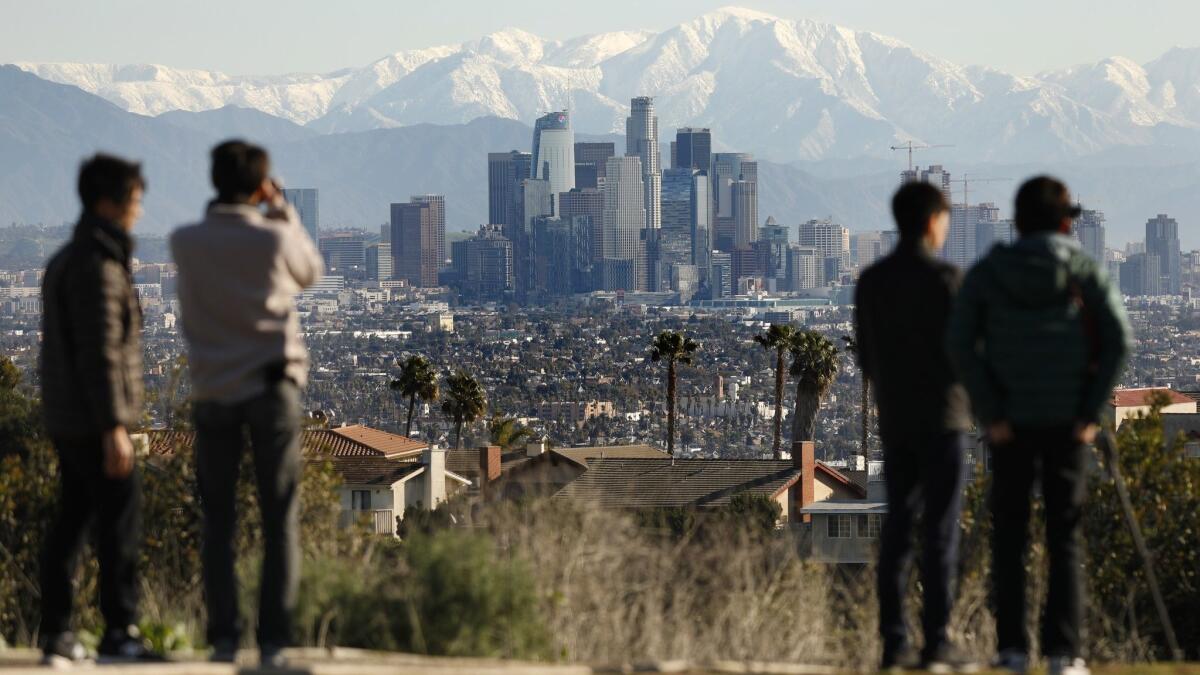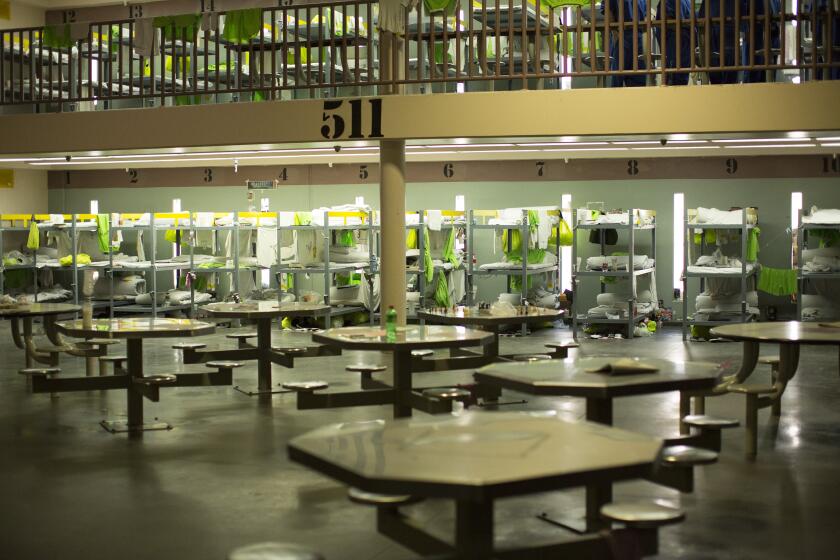Must Reads: A February to remembrrr in L.A.: It never even reached 70 degrees

- Share via
Home restaurant’s sprawling outdoor patio in Los Feliz, set under a canopy of large trees, was designed to take advantage of California’s temperate climate and typically sunny skies.
But this February has been so cold that the restaurant scrambled to set up extra heaters outside the Craftsman-style house to keep diners and workers warm during the record-setting cold winter.
“We had three heaters going for a while and this month it just hasn’t been enough,” said Sam Yoo, a manager at the restaurant. “I’m trying to have the waiters and hostesses wear warmer clothing, but I have one heater set up right by the host stand so they don’t catch colds.”
For the first time since forecasters began recording data — at least 142 years — the mercury did not reach 70 degrees in downtown Los Angeles for the entire month of February.
The average high for the month was 61 degrees, significantly lower than the historical average of 68 for February. That makes it the eighth-coldest February on record, said Ryan Kittell, a meteorologist with the National Weather Service in Oxnard.
“Most of the time we’ll get one or two Santa Ana wind events in between the rain that would give us temperatures above 70 degrees,” he added. “But it’s just been back-to-back storms and no offshore flows.”
It’s a big change for Southern California, where temperatures having been rising to record levels in recent years along with a prolonged drought. Weather experts said the chilly February doesn’t signal a larger change in some of those trends.
Even factoring in the cold snap, California is still warmer than average, and swings between periods of severe winter rainstorms and profound drought will probably become more pronounced in the future because of climate change, said Daniel Swain, a climate scientist at UCLA.
He added that it might not be as cold as locals perceive it to be given how much warmer it has been in the last several years.
“This year seems anomalous because we have already internalized a lot of the warming that’s occurred,” he said.
On Thursday, a light drizzle blanketed the barren streets of Santa Monica. Mist clung to the tops of palm trees that swayed in the wind and the sky was so gloomy that the ocean was barely visible from a few blocks away. A lone street artist with a guitar crooned the opening chords of Leonard Cohen’s “Hallelujah,” but most people wrapped in heavy coats and armed with umbrellas sped by without lingering to listen.
Samantha Nava, 26, woke up early to commute from downtown to Santa Monica College, where she’s studying journalism. The L.A. native pulled on jeans, a thin shirt and a dark denim jacket and capped it off with a beanie, but said she always feels ill-prepared for the cold.
“I tend to wear one layer because it’s L.A. and I keep expecting it’s going to get warmer, but it doesn’t,” she said.
Several factors — including a lack of offshore wind and, more broadly, climate change — have played into California’s weird winter weather, experts say.
The recent cold snap has also brought snow to portions of the Southland that rarely see any. It stems, in part, from a weakening polar vortex — a wide expanse of swirling cold air in Earth’s poles. When the polar vortex is strong, there’s powerful west-to-east wind that traps cold air in the Arctic. If it weakens and the air is no longer a continuous band, cold air can spill out of the Arctic and move down to the West Coast, Swain said.
The city came close — within one degree — of hitting the 70 mark, but it never quite warmed up enough to get there.
“There’s plenty of days in January and February where people want to go to the beach and we usually get a few of those days every winter,” Kittell said. “We haven’t had any in February.”
On sunny winter days — and even drizzly ones — beachgoers can easily spot surfers bobbing in the crisp ocean water waiting for the perfect wave to catch back to shore. Die-hard surfers brave the elements year-round regardless of the cold, but this year beaches up and down the Southern California coast have been more frequently empty.
Kevin Cuthbertson usually rides waves rain or shine, but even he hasn’t been in the water for six weeks. Most of his friends have been out of the ocean for a month, a tough reality for a group that sees being in the water as an essential part of life on the West Coast.
It’s cold and dirty, and the swells are mediocre compared to what’s typical when a winter storms roll in. The cold also makes it difficult to move and jump on the board when a wave finally forms, he said.
“Ice cream headaches, some people get that,” the 72-year-old added. “I feel it in my hands and feet, even though I have booties and gloves. After a while, the cold seeps in.”
Not everyone in Southern California is singing the winter blues. Back-to-back winter storms this year have blanketed California’s mountain ranges with snow, making this a banner winter for skiers and snowboarders.
The storms have covered Mountain High Resort in Wrightwood with more than 8 feet of fresh snow this winter, while Big Bear Mountain Resort has received more than 10 feet. This season has provided the best conditions for snow sports in roughly a decade, said John McColly, vice president of sales and marketing at Mountain High, who added that it “feels like a real winter this year.”
Matt Martinez, 41, is an avid surfer who spends the colder months chasing storms that provide local mountains with a blanket of fresh powder. He likens riding hard-packed artificial snow created by local resorts to sending a skateboard down a paved street. Gliding on softer fresh snow, he said, is like catching a wave in the ocean.
“The big allure for me is chasing that fresh track down the mountain and trying to find that perfect run,” the San Pedro resident said. “When you’re drawing your line down the mountain, you get this weightless feeling like you’re gliding on nothing.”
Twitter: @Hannahnfry
More to Read
Sign up for Essential California
The most important California stories and recommendations in your inbox every morning.
You may occasionally receive promotional content from the Los Angeles Times.













